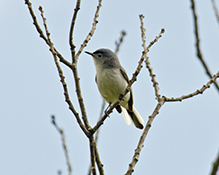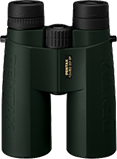Blue-gray Gnatcatcher
(Polioptila caerulea)
Conservation • Description • Habitat • Ecology • Distribution • Taxonomy
Conservation Status |
|||
| IUCN Red List | LC - Least Concern |
||
| NatureServe | N5B, N5N - Secure Breeding and Nonbreeding SNRB - Unranked Breeding |
||
| Minnesota | not listed |
||
Description
The upper parts are bluish-gray. The underparts are pale gray.
The breeding male has a black forehead. There is a white eye ring.
The outer tail feathers are white.
The legs are dark.
Size
Total length: 4½″
Wingspan: 6″
Voice
The morning to noon song is a 10 or more second long jumble of thin wheezy notes, high chips, and high whistles, often including small bits that mimic parts of other bird songs – zeet zeet zeet zill zill zwee zwee …
Similar Species
Habitat
Deciduous woodland edges
Ecology
Migration
Late April through August
Nesting
Food
Distribution
Occurrence
Uncommon migrant and breeder
Maps
The Minnesota Ornithologists’ Union All Seasons Species Occurrence Map
Taxonomy
Class
Aves (birds)
Order
Passeriformes (perching birds)
Family
Polioptilidae (gnatcatchers and gnatwrens)
Genus
Polioptila (gnatcatchers)
Subordinate Taxa
Bahamas Blue-gray Gnatcatcher (Polioptila caerulea caesiogaster)
Blue-gray Gnatcatcher (Polioptila caerulea deppei)
Blue-gray Gnatcatcher (Polioptila caerulea nelsoni)
Blue-gray Gnatcatcher (Polioptila caerulea perplexa)
Cozumel Blue-gray Gnatcatcher (Polioptila caerulea cozumelae)
Eastern Blue-gray Gnatcatcher (Polioptila caerulea caerulea) ![]()
San Lucas Gnatcatcher (Polioptila caerulea obscura)
Western Gnatcatcher (Polioptila caerulea amoenissima)
Synonyms
Motacilla caerulea
Visitor Photos
Share your photo of this bird.
This button not working for you?
Simply email us at info@MinnesotaSeasons.com.
Attach one or more photos and, if you like, a caption.
Christa Rittberg |
 |
MinnesotaSeasons.com Photos
|
|

Slideshows

Visitor Videos
Share your video of this bird.
This button not working for you?
Simply email us at info@MinnesotaSeasons.com.
Attach a video, a YouTube link, or a cloud storage link.
Other Videos
Blue-gray Gnatcatcher
Larry Bond
Blue Gray Gnatcatcher
MyBackyardBirding
Blue-Gray Gnatcatcher
Ricky L Jones
Blue-gray Gnatcatcher 5/21/2017
Dalibor Mrkic

Visitor Sightings
Report a sighting of this bird.
This button not working for you?
Simply email us at info@MinnesotaSeasons.com.
Be sure to include a location.
MinnesotaSeasons.com Sightings
